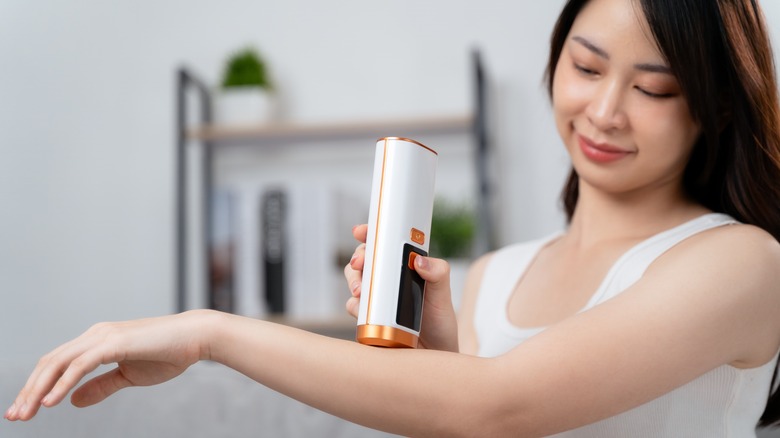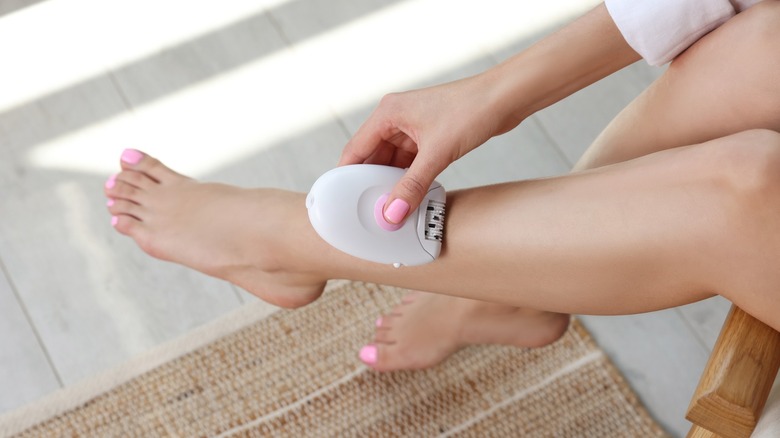Mistakes You May Be Making With Your Epilator
We may receive a commission on purchases made from links.
If you've ever used an epilator, you probably know it takes some trial and error. The tool is designed to remove hair from the root for longer-lasting results than shaving (which cuts down the hair but leaves the root intact) while providing smoother results. However, licensed esthetician and owner of Gregory Dylan Skincare, Gregory Dylan, exclusively tells Women, "[It can] sometimes be a bit uncomfortable for newbies." And he's not wrong.
Not only can epilators be a little painful when they remove the hair, but using them incorrectly can cause redness, irritation, and hair breakage. That's why it's so important to get your technique down for the best results. To take out some of the guesswork, we asked Dylan about the biggest mistakes people make with epilators and how to avoid them (just remember body hair is personal and not up for debate, so you should only be removing it for yourself).
Not preparing your skin properly
If your epilator isn't giving you the best results, it may come down to skin prep. Exfoliating is one of the easiest, most important ways to prep your skin. Not only does it create a clean canvas (removing the likes of make-up, self-tanner, or perfumes), but it also reduces dead skin cells for a more effective, clean result. "Exfoliating beforehand will not only help get a better result but will help to prevent ingrown hairs down the line as well," Gregory Dylan tells us, recommending a shower scrub or a dry brush. Try Kitsch's Dry Brushing Body Brush and Exfoliating Body Scrubber or EcoTools' Dry Body Brush, then see our tips for keeping your dry brush clean for optimum results. Exfoliating in a warm shower or bath pre-epilate can also open pores and soften the hair, making the removal process easier and less uncomfortable.
Another way to prep the skin is to ensure your hair is the right length. For most devices, that means no longer than 5mm. That will allow each strand to be removed as easily and pain-free as possible, but check the instructions of your epilator for tailored advice.
Using the wrong method
Just like shaving, there's a proper technique with epilators to get the most effective results, and you may be tilting the device too much or moving too quickly. Try holding your epilator at a 75-degree angle (too much of a tilt can break the hair, stopping it from being removed properly) against the skin and gently pull the area around it to keep it smooth. "You want to keep the skin taught and run the epilator upward, against the hair growth," Gregory Dylan says. "This allows the hair to be lifted and 'grabbed' by the disks and is helpful for shorter hairs." He also suggests taking things slow, as rapidly running the device along the skin can also break the hairs. You may get better results in a warm environment because somewhere too cold can create goosebumps, making it harder for the device to get close to the skin.
"Practice makes perfect, but epilation can be tricky at first. Work on your technique, holding and gliding the device, etc.," Dylan says. Rehearse your motion with the epilator turned off, then switch it on and adapt your movements based on how effectively it extracts the hair.
Expecting miracle results immediately
Another major mistake people make with their epilator is using it too close to a big event and expecting flawless skin. Razors can create annoying razor bumps (though there are ways to prevent them) and, although epilators can be key to avoiding those bumps, they could still leave red marks or cause irritation. "You won't want to do it right before an event. Be sure and give yourself at least 24 hours between epilating and showing off your skin to allow ample time for the skin to calm down," Gregory Dylan shares.
Many people also expect too much. Epilation won't permanently remove hair, but it can make the skin smoother for around four weeks. If you want hair removal that lasts longer, IPL or laser hair removal may be better. Equally, hair growing back softer and less noticeable will take a few sessions. If you want the peace of mind of knowing any missed hairs will be more subtle, start epilator sessions a few months before an event. At first, try epilating each week, then settle into a less regular routine, such as once every three weeks.
Not keeping it clean
Much like other beauty devices and tools, many people make the mistake of forgetting to clean their epilator properly and regularly — though it's imperative for the device and your skin. "Clean it regularly to keep the epilator working consistently and to prevent bacterial or fungal infections," Dr. Choi Kim, a board-certified medical and cosmetic dermatologist, told Byrdie. "Even if it is a device that can be used wet, don't leave it in your shower where it can breed bacteria and fungus easily."
To clean your epilator, take off all the attachments and remove any hairs using a brush. Many devices come with a cleaning tool, such as a brush or a cloth, but you could use a clean makeup brush. If your device is waterproof, rinse it with water and dry it properly, then use rubbing alcohol to kill germs and bacteria. Repeat these steps each time you use the device.
Using the wrong epilator
Not all epilators are created equal and you may find some work better for you than others. One of the major differences is if they're designed to be used wet or dry. "Wet allows you to epilate in the shower and may be better for more sensitive skins versus a dry device," Gregory Dylan tells us, so it's worth trying a waterproof version if you experience irritation or feel itchy after epilating. A wet device may also be better for those who usually shave and like the cleanliness of removing body hair in the bath or shower. Dylan noted some epilators have both wet and dry settings, including the Braun Epilator Silk-épil 9 Flex SkinSpa or Philips' Epilator Series 8000.
It's also worth considering the size and shape, as well as which body parts you predominantly use it on. Some epilators have longer handles for harder-to-reach areas, and others have different head attachments for specific areas of skin, so consider your personal preferences and needs.





